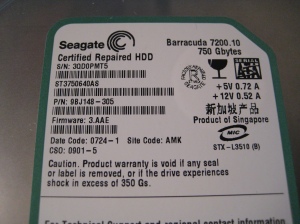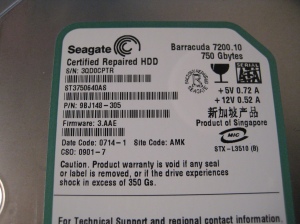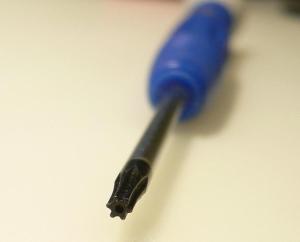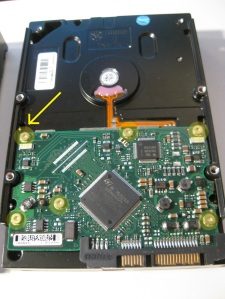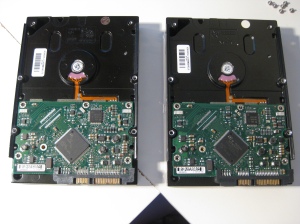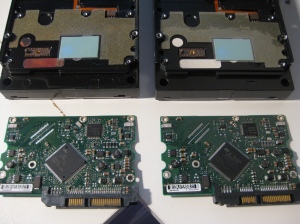There are several situations that may indicate a problem with your hard drive. The methods listed here are not guaranteed ways to save the hard drive, but rather an attempt to recover information before tossing out the hard drive. If you do not feel comfortable doing this yourself, please refer it to professionals. Naturally, the best way to prevent this is to make sure the information is backed up elsewhere.
Problem:
The hard drive is making audible “clicking” or “ticking” noises. This is “click-click-click” or “tick-tick-tick,” … pause… “tick-tick-tick”. Do not confuse this with the regular “rrr-rrr-rrr” sound the hard drive makes when it is reading normally. The clicking is very distinctive and you should notice a dramatic decline in performance. The computer may shut down unexpectedly too.
Cause:
Also known as the “click of death,” the hard drive’s head on the reading arm is making contact with the surface of the metal disk. The arm could also be hitting me the rotor and repetitively loading and unloading.
Possible solution(s):
First, attempt to back up whatever data you can IMMEDIATELY. If you don’t have an external hard drive or flash drive, turn off the computer and go get one. Because once the computer starts clicking, you typically have very little time left to backup and your computer will only work for 10-15 minutes at a time, or maybe shorter. The reason is that metal to metal contact creates friction which causes heat to increase and then the drive will shut down. Essentially, as you are backing up, the life of the drive will degrade and die very soon.
Now, if you search online, you will find the “freezer” method discussed, where people put the hard drive into a zip lock bag and throw it in the freezer for a few hours. By doing this, people hope that metal parts would shrink inside, temporarily disengaging physical contact of the metal pieces, thus reducing heat. It does work in some cases, but unfortunately, not all the time.
Another method that might work is to replace the logic board on the hard drive with another one from an identical drive. See below for instructions for changing logic boards due to loss of power.
Problem:
The hard drive is making an audible screeching sound. It is one continuous screeching sound as like nails on a chalkboard.
Cause:
This is when the reading arm is broken or dislocated, and now the head is making complete contact with the surface of the hard drive. It’s like putting a screwdriver against the side of a bench grinder.
Possible solution:
***WARNING*** I DO NOT RECOMMEND THIS METHOD BECAUSE THE CHANCES FOR SUCCESSFUL RECOVERY IS LESS THAN 5%! ****
Wear gloves and remove the top cover off the hard drive carefully with a torx screwdriver (T-8). You see the location of the arm by a ring created on the surface of the disk that looks like the arm has carved into the disk and discolored it by leaving a deep groove.
If you see this, the arm is broken, and probably not repairable. If you don’t see that ring, perhaps the arm is dislocated due to shock or something, and you can try to move it to dislodge it back into place. Try powering up the drive and see if it moves properly again. If it does, then good news and start backup immediately. If it doesn’t, you may want to identify the problem, if possible, and see if the drive will be recognizable.
Essentially the drive is going to be destroyed once the cover comes off in a short period of time. So, please use this as a last resort.
Problem:
The drive on the computer disappears. You check that your drive is plugged in, but it’s not receiving any power. It’s like a dead drive – doesn’t spin up or make any whirring sounds at all.
Cause:
Most likely, this is due to a defective, faulty, or broken logic board. The logic board is the “brain” to control the hard drive and provide power management.
Possible solution:
Usually, the solution for when a hard drive does not power up, or acts up intermittently is to swap out the logic board with another one. Listed below are the steps to swap logic boards.
Make sure the drives are same. Same manufacturer, model, capacity, speed (rpm), and firmware. If the firmware is not the same, it will display an error.
Use a torx screwdriver and remove the screws from the bottom side of the hard drive.
Swap the logic board, and put the screws back.
Your drive should have power and work without any problems. If everything is fine, start backup immediately. If you hear clicking sounds, still start backup as soon as you can because the drive is in bad shape. Good luck!

